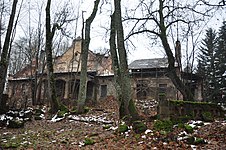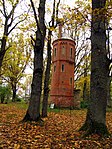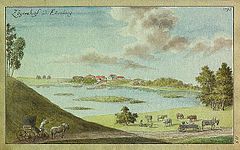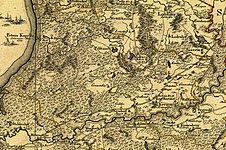Sēja Manor
Sēja Manor (Latvian: Sējas muiža; German: Zögenhof) is a knight's manor in Saulkrasti Municipality in the Vidzeme region of Latvia. It was formerly situated in Kreis Riga in the Governorate of Livonia.[1]
History

The manor, which used to be named Ennenberg, was acquired by Johan Seyge (Zöge) in 1577.[3][4][5][6] The Latvian name of Sēja Manor comes from the surname of the previous landlord, Andrejs Seija.[7] The present ruined manor house was first built in 1766. From 1751 until the Latvian agrarian reform in the 1920s, the manor belonged to the noble Dunten family, which was related to the famous Münchhausen family. Hieronymus Carl Friedrich von Münchhausen spent several years in Livonia and in 1744 married Jacobine von Dunten, daughter of baron von Dunten.[8] In 1883–1885 manor house was rebuilt and added sophisticated neo-Gothic decorations to its modest baroque mansion features – openwork cast iron castings, balustrades and sandrics.[9][1]
As the count also had residences in Dunte (Ruthern), Mūrmuiža (Muremoise), Skulte and Germany, during his absence the main supervisor of the manor was majordomo Tor, later Apsītis and Eduards Siliņš.[10]
The manor, depicted in maps from the 1790s, was situated adjacent to a lake that was later drained and ceased to appear on maps after 1905.
After state of Latvia confiscated manor from von Dunten family in 1920, the property was divided into smaller land lots and in manor house a club was established. In Soviet Latvia from 1963 to 1968, the manor house hosted club of the collective farm "Komunārs" and also library operated there. At the beginning of the 1990s, the office of the 2nd district of the kolkhoz "Bolsheviks" operated in the manor.[10] Presently building is partially collapsed and in state of ruins.[1]
Besides main manor house property also has an old oak tree, 18th century granary and a water tower built in 1903.[9]
Archaeology
Artifacts from ancient Livonian stone box grave culture has been found on Sēja Manor land.[11] They are similar to other Balti mound graves in the lower Gauja area, which were called batariņi. Ancient tombs were also in the wider region, but most likely, due to the spread of agriculture, many places were destroyed in ancient times. In the 19th century, Baltic-German archaeologists Georg Loeschcke, R. Hausmann, L. Schroeder and Anton Buchholtz excavated this type of mound graves and described them in the literature as the ancient graves of Neuhof or Zögenhof.[12][13]
Gallery
-
 Seja manor around year 1910
Seja manor around year 1910 -
 Seja manor in 2002
Seja manor in 2002 -
 Seja manor in 2016
Seja manor in 2016 -

-

-
 Water tower
Water tower -

-
 Lake, which was drained, was located near Seja manor. Drawing by Johann Christoph Brotze in 1794
Lake, which was drained, was located near Seja manor. Drawing by Johann Christoph Brotze in 1794 -
 1791 map of Kirchspiel Kremon-St. Peters Capelle with location of Seja manor (Zogenhof) and the nearby lake
1791 map of Kirchspiel Kremon-St. Peters Capelle with location of Seja manor (Zogenhof) and the nearby lake
See also
References
- ^ a b c (in Latvian) Sējas pils (drupas)
- ^ Excerpt from the map Wegekarte des Rigaschen Kreises mit den Kirchspiels- und Gutsgrenzen (1905).
- ^ "Indriķa hronika. XI". old.historia.lv. Retrieved 2023-02-23.
- ^ "Anno". Historia (in Latvian). Retrieved 2023-02-23.
- ^ "Latvis, Nr.128 (03.02.1922) - Vidzemes muižu nosaukumi". periodika.lv. February 3, 1922. Retrieved 2023-02-23.
- ^ Carl von Löwis of Menar (1922). Burgenlexikon für Alt-Livland : mit 24 Plänen und 56 Ansichten (PDF). Riga: Verlag der Aktiengesellschaft Walters und Rapa.
Zögenhof hiess früher Enneberg. (Burg des. Anno?)
- ^ "Antiquitas Viva 5, studia classica" (PDF). University of Latvia. 2019.
- ^ Jacobine von Dunten
- ^ a b "Zudusī Latvija - Sējas muiža. Muižas pils". www.zudusilatvija.lv. Retrieved 2023-02-23.
- ^ a b Landsberga, Līga (2016-05-27). "Latvijas muižas un pilis un citas interesantas vietas: Duntes muiža (Ruthern, Rutershoff, Ruterhoff, Roude)". Latvijas muižas un pilis un citas interesantas vietas. Retrieved 2023-02-23.
- ^ (in German) Jakob Ozols Die baltische Steinkistengräberkultur, Volume 16 of Vorgeschichtliche Forschungen. Publisher De Gruyter, 219 pages 1969
- ^ Apals, Jānis; Mugurēvičs, Ēvalds; Vasks, Andrejs (2001). Latvijas senākā vēsture. Latvijas vēstures institūta apgāds. ISBN 9789984601519.
- ^ Arheologu pētījumi Latvijā 1998. un 1999. gadā. 2000.
- v
- t
- e
| Latgale | |||||||
|---|---|---|---|---|---|---|---|
| Selonia |
| ||||||
| Zemgale | |||||||
| Kurzeme | |||||||
| Vidzeme |
|

- Adamova
- Aizupe
- Apriķi
- Arendole
- Asare
- Aumeisteri
- Baldone
- Bebrene
- Beļava
- Bēne
- Biksēre
- Biksti
- Blankenfelde
- Boja
- Bornsminde
- Bramberģe
- Brukna
- Cēre
- Cirsti
- Dikļi
- Dole
- Drabeši
- Dunalka
- Durbe
- Dursupe
- Dzelzava
- Dzērbene
- Dzērve
- Dzimtmisa
- Ērberģe
- Eversmuiža
- Ezere
- Felicianova
- Gārsene
- Igate
- Ilga
- Īvande
- Jaunauce
- Jaungulbene
- Jaunmokas
- Jaunmuiža
- Jasmuiža
- Jaunsvente
- Jumurda
- Juzefinova
- Kabile
- Kalna
- Kalnmuiža
- Kameņeca
- Katvari
- Kaucminde
- Kokmuiža
- Lamiņi
- Lielauce
- Lielmēmele
- Lielzalve
- Liepa
- Linde
- Litene
- Lizums
- Lūznava
- Malnava
- Mālpils
- Mazsalaca
- Mencendarbe
- Mežmuiža
- Mūrmuiža
- Naukšēni
- Nogale
- Odziena
- Ozolmuiža
- Padure
- Palsmane
- Pasiene
- Pastende
- Puikule
- Reģi
- Remte
- Reņģe
- Rikava
- Salnava
- Sasmaka
- Sēja
- Sērmūkši
- Skaistkalne
- Stende
- Stukmaņi
- Suntaži
- Svēte
- Svitene
- Šēnheida
- Šķēde
- Tāšu-Padure
- Taurupe
- Tiņģere
- Trapene
- Ungurmuiža
- Vadakste
- Vaiņode
- Valdeķi
- Vandzene
- Vāne
- Vārkava
- Varme
- Vecauce
- Vecbebri
- Vecborne
- Vecgulbene
- Vecmēmele
- Vecsaliena
- Veselava
- Vestiena
- Zaļā
- Zaļenieki
- Zante
- Zasa
- Zemīte
- Ziemeri
- Zvārtava
  | This article about a castle, palace or manor house in Latvia is a stub. You can help Wikipedia by expanding it. |
- v
- t
- e




















